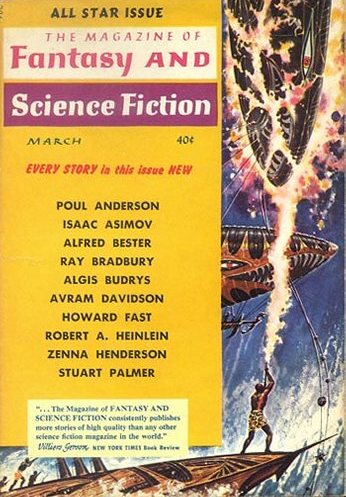Last time on this station, I informed all of you that Part 2 of this (last) month's Fantasy & Science Fiction review would have to wait since I'd wanted to get through the Poul Anderson novelette before reporting.
Well, I'm glad I did. Damn that Anderson, anyway. How dare he write a good story! Now I can't justify skipping him. But more on that later.
Of Time and Cats by Howard Fast, who normally doesn't dip his toe in the science fiction pool, is a fun tale of the multiplicity that ensues when time travel is involved. A slick, paradoxical story.
Algis Budrys has another winner with The Distant Sound of Engines about impending death and the urgent need to impart a lifetime's accumulated wisdom before final departure. Sad. Good.
Avram Davidson's The Certificate is dystopic in the extreme, and probably inspired by the recent Holocaust. A subjugated humanity is reduced to bitter slave labor. The only "gift" from their new overlords is perfect health. How does one escape?

I liked Three Dimensional Valentine by Stuart Palmer (who had a story in the very first F&SF) quite a lot. It is fun and frivolous and rather old-fashioned. It is also unexpected. The author has given me permission to distribute this one, but I haven't quite received it in the mails yet. I'll let you know when I do.
And now to Poul Anderson's The Sky People. As you know, I always approach Anderson with trepidation. Apart from the amazing Brainwave, his work is generally turgid, and I don't like his manly men and absent women.
This one was different. There is still plenty of swashbuckling in this post-apocalyptic tale, but it is done in the style and with the flaire of a good pirate movie like Black Swan. It is set in old San Antone, in the heart of the decaying "Meycan" Empire, south of Tekas and north of S'america. Their technology and mindset is mired in the 16th century. The eponymous "Sky People" are dirigible-driving corsairs from the Kingdom of "Canyon." Though rapacious and ruthless, they possess a greater technology than their target–the Meycans. Unfortunately for them, the timing of their attack proves to be inauspicious as it coincides with the arrival of a delegation from the Federation, successors to the Polynesian nations of Oceania.

Told by three viewpoint characters, one Polynesian, one sky pirate, and one Meycan (a woman!), it is really quite good. Not only has Anderson managed to convincingly portray a wide variety of cultures, he has done a fine job of projecting recovery from an atomic catastrophe in a world that has used up most of its natural resources. I don't know if Anderson has written other stories in this universe or if he intends to, but I would enjoy reading more.
The final story is Alfred Bester's Will You Wait?. The deal with the Devil story has been just about done to death, but this is an infernally cute story about how the modern way of business has made the process Hell on Earth.
Gosh, where does that leave us for the issue? 4 stars? 4 and a half? Definitely a good read worth picking up–if there are any left on the stands, that is.
See you on the 12th!
(Confused? Click here for an explanation as to what's really going on)
This entry was originally posted at Dreamwidth, where it has comments. Please comment here or there.

















